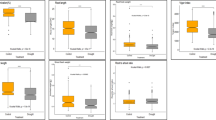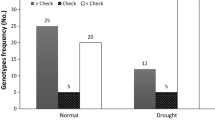Abstract
Simulating drought stress during the breeding process has been proposed as a way to select varieties under naturally non-stressful conditions. The aim of the study was to characterise the genetic basis of the response of 111 spring wheat (Triticum aestivum L.) varieties and landraces to chemical desiccation and to rain-out shelter drought. The effect of the rain-out shelter was a 15% reduction in plant height, spike length and thousand seed weight (TSW); in contrast, the desiccant treatment induced a 15% reduction in seed number, a 35–72% loss in TSW and a reduction in subsequent germination of 12%. A genome-wide association analysis revealed 263 significant marker-trait associations (MTAs), of which 246 involved days to anthesis, plant height, spike length, number of spikelets, seed number, TSW and germination from the non-treated plants. Only four and five MTAs involved TSW from plants grown under the rain-out shelter and the chemical desiccation, respectively, and harboured the Sugar-Dependent6 gene. Seven MTAs involved seed number for chemical desiccated plants. Both, chemical desiccation and rain-out shelter drought identified same tolerant genotypes. Concluding, both approaches are suitable to simulate different drought scenarios. However, there was a strong environmental impact for chemical desiccation which may increase the complexity of this tolerance mechanism.





Similar content being viewed by others
References
Bhargava S, Sawant K (2013) Drought stress adaptation: metabolic adjustment and regulation of gene expression. Plant Breed 132:21–32. https://doi.org/10.1111/pbr.12004
Blum A (1998) Improving wheat grain filling under stress by stem reserve mobilisation (reprinted from wheat: prospects for global improvement, 1998). Euphytica 100:77–83. https://doi.org/10.1023/A:1018303922482
Blum A, Poiarkova H, Golan G, Mayer J (1983) Chemical desiccation of wheat plants as a simulator of post-anthesis stress. 1. Effects on translocation and kernel growth. Field Crop Res 6:51–58. https://doi.org/10.1016/0378-4290(83)90047-3
de Carvalho MAAP, Bebeli PJ, Bettencourt E, Costa G, Dias S, Dos Santos TMM, Slaski JJ (2013) Cereal landraces genetic resources in worldwide GeneBanks. A review. Agron Sustain Dev 33:177–203. https://doi.org/10.1007/s13593-012-0090-0
Dong Y et al (2016) Genome-wide association of stem water soluble carbohydrates in bread wheat. PLoS One 11:e0164293. https://doi.org/10.1371/journal.pone.0164293
Farooq M, Hussain M, Siddique KHM (2014) Drought stress in wheat during flowering and grain-filling periods. Crit Rev Plant Sci 33:331–349. https://doi.org/10.1080/07352689.2014.875291
Fischer RA, Maurer R (1978) Drought resistance in spring wheat cultivars. 1. Grain yield responses. Aust J Agric Res 29:897–912
Gahlaut V, Jaiswal V, Tyagi BS, Singh G, Sareen S, Balyan HS, Gupta PK (2017) QTL mapping for nine drought-responsive agronomic traits in bread wheat under irrigated and rain-fed environments. PLoS One 12. https://doi.org/10.1371/journal.pone.0182857
Gupta P, Rustgi S, Kulwal P (2005) Linkage disequilibrium and association studies in higher plants: present status and future prospects. Plant Mol Biol 57:461–485. https://doi.org/10.1007/s11103-005-0257-z
Haley SD, Quick JS (1998) Methodology for evaluation of chemical desiccation tolerance in winter wheat. Cereal Res Commun 26:73–79
ISTA (2014) International rules for seed testing. International Seed Testing Association, Bassersdorf
Ma J et al (2017) Transcriptomics analyses reveal wheat responses to drought stress during reproductive stages under field conditions. Front Plant Sci 8. https://doi.org/10.3389/fpls.2017.00592
Mackay I, Powell W (2007) Methods for linkage disequilibrium mapping in crops. Trends Plant Sci 12:57–63. https://doi.org/10.1016/j.tplants.2006.12.001
Mwadzingeni L, Shimelis H, Rees DJG, Tsilo TJ (2017) Genome-wide association analysis of agronomic traits in wheat under drought-stressed and non-stressed conditions. PLoS One 12. https://doi.org/10.1371/journal.pone.0171692
Nasehzadeh M, Ellis RH (2017) Wheat seed weight and quality differ temporally in sensitivity to warm or cool conditions during seed development and maturation. Ann Bot-London 120:479–493. https://doi.org/10.1093/aob/mcx074
Nezhad KZ et al (2012) QTL analysis for thousand-grain weight under terminal drought stress in bread wheat (Triticum aestivum L.). Euphytica 186:127–138. https://doi.org/10.1007/s10681-011-0559-y
Nicolas ME, Turner NC (1993) Use of chemical desiccants and senescing agents to select wheat lines maintaining stable grain size during post-anthesis drought. Field Crop Res 31:155–171. https://doi.org/10.1016/0378-4290(93)90058-U
Price AL, Patterson NJ, Plenge RM, Weinblatt ME, Shadick NA, Reich D (2006) Principal components analysis corrects for stratification in genome-wide association studies. Nature Genet 38:904–909. https://doi.org/10.1038/ng1847
Quettier A-L, Shaw E, Eastmond PJ (2008) SUGAR-DEPENDENT6 encodes a mitochondrial flavin adenine dinucleotide-dependent glycerol-3-P dehydrogenase, which is required for glycerol catabolism and postgerminative seedling growth in Arabidopsis. Plant Physiol 148:519–528. https://doi.org/10.1104/pp.108.123703
Royo C, Blanco R (1998) Use of potassium iodide to mimic drought stress in triticale. Field Crop Res 59:201–212. https://doi.org/10.1016/S0378-4290(98)00121-X
Salem KFM, Röder MS, Börner A (2007) Identification and mapping quantitative trait loci for stem reserve mobilisation in wheat (Triticum aestivum L.). Cereal Res Commun 35:1367–1374. https://doi.org/10.1556/Crc.35.2007.3.1
Samarah N, Alqudah A (2011) Effects of late-terminal drought stress on seed germination and vigor of barley (Hordeum vulgare L.). Arch Agron Soil Sci 57:27–32. https://doi.org/10.1080/03650340903191663
Sawhney V, Singh DP (2002) Effect of chemical desiccation at the post-anthesis stage on some physiological and biochemical changes in the flag leaf of contrasting wheat genotypes. Field Crop Res 77:1–6. https://doi.org/10.1016/S0378-4290(01)00192-7
Storey JD (2003) The positive false discovery rate: a Bayesian interpretation and the q-value. Ann Stat 31:2013–2035. https://doi.org/10.1214/aos/1074290335
Su ZQ, Hao CY, Wang LF, Dong YC, Zhang XY (2011) Identification and development of a functional marker of TaGW2 associated with grain weight in bread wheat (Triticum aestivum L.). Theor Appl Genet 122:211–223. https://doi.org/10.1007/s00122-010-1437-z
Trnka M, Rotter RP, Ruiz-Ramos M, Kersebaum KC, Olesen JE, Zalud Z, Semenov MA (2014) Adverse weather conditions for European wheat production will become more frequent with climate change. Nat Clim Chang 4:637–643. https://doi.org/10.1038/Nclimate2242
Varshney RK et al (2012) Genome wide association analyses for drought tolerance related traits in barley (Hordeum vulgare L.). Field Crop Res 126:171–180. https://doi.org/10.1016/j.fcr.2011.10.008
Vishwakarma K et al (2017) Abscisic acid signaling and abiotic stress tolerance in plants: a review on current knowledge and future prospects. Front Plant Sci 8. https://doi.org/10.3389/fpls.2017.00161
VSN International (2013) GenStat for Windows, 17th edn. VSN International, Hemel Hempstead Web page: GenStat.co.uk
Wang S et al (2014) Characterization of polyploid wheat genomic diversity using a high-density 90 000 single nucleotide polymorphism array. Plant Biotechnol J 12:787–796. https://doi.org/10.1111/pbi.12183
Wickham H (2009) ggplot2: elegant graphics for data analysis. Springer, New York
Wilcox J, Makowski D (2014) A meta-analysis of the predicted effects of climate change on wheat yields using simulation studies. Field Crop Res 156:180–190. https://doi.org/10.1016/j.fcr.2013.11.008
Yamasaki Y, Gaol F, Jordan MC, Ayele BT (2017) Seed maturation associated transcriptional programs and regulatory networks underlying genotypic difference in seed dormancy and size/weight in wheat (Triticum aestivum L.). BMC Plant Biol 17. https://doi.org/10.1186/s12870-017-1104-5
Zadoks JC, Chang TT, Konzak CF (1974) A decimal code for the growth stages of cereals. Weed Res 14:415–421. https://doi.org/10.1111/j.1365-3180.1974.tb01084.x
Acknowledgments
Anna Marthe, Allah Bakhsh, Sibylle Pistrick, Annett Marlow, Peter Schreiber, Philip Kouria and the past and current staff of the IPK gene bank as well as Freta K. Balladona and Farhadz Fadhillah Sandi are gratefully acknowledged for their technical support and Wolfgang Link for statistical advice.
Author contributions statement
MN, AB and UL designed the work; RT, MN, FS, IM, AMA, ST and MR acquired and analysed the data; RT and MN wrote the original draft of the manuscript and AMA, AB, RT and MN critically revised the content. All authors read and approved the manuscript.
Funding
This study was funded by the DAAD (Rasha Tarawneh).
Author information
Authors and Affiliations
Corresponding author
Ethics declarations
Conflict of interest
The authors declare that they have no conflict of interest.
Ethical approval
This article does not contain any studies with human participants or animals performed by any of the authors.
Additional information
Communicated by: Barbara Naganowska
Publisher’s note
Springer Nature remains neutral with regard to jurisdictional claims in published maps and institutional affiliations.
Electronic supplementary material
ESM 1
(DOCX 3.50 mb)
Rights and permissions
About this article
Cite this article
Tarawneh, R.A., Szira, F., Monostori, I. et al. Genetic analysis of drought response of wheat following either chemical desiccation or the use of a rain-out shelter. J Appl Genetics 60, 137–146 (2019). https://doi.org/10.1007/s13353-019-00494-y
Received:
Revised:
Accepted:
Published:
Issue Date:
DOI: https://doi.org/10.1007/s13353-019-00494-y




